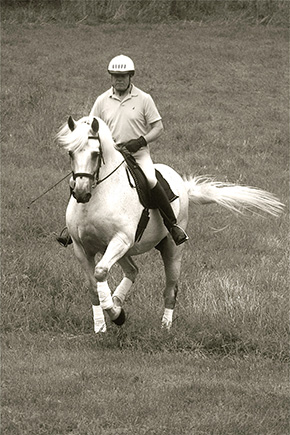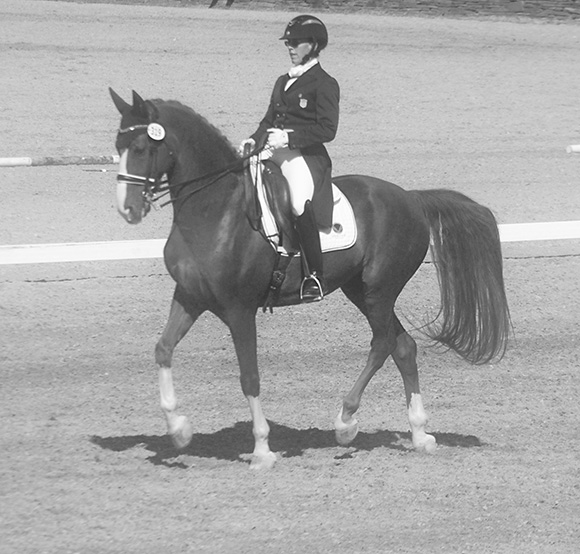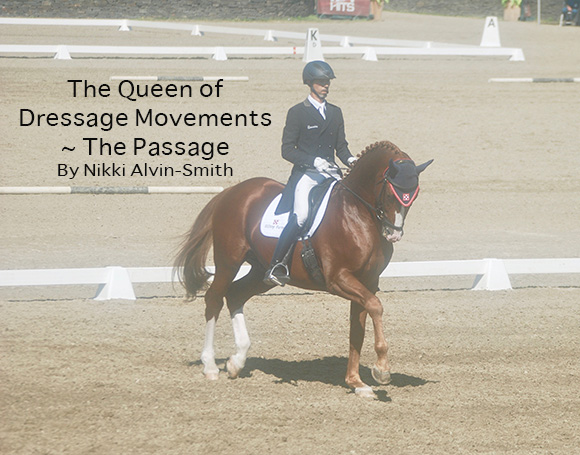The Queen of Dressage Movements ~ The Passage
By Nikki Alvin-Smith
Here at Catskill Horse magazine, I previously discussed the ‘King of Dressage Movements’ ~ the Piaffe. What comes next? The wonderful movement of passage.
There are many similarities between the two movements in their requirements. A soft rhythmical collected trot gait with even diagonal footfalls, a light elastic contact with the rein, arched neck and head slightly in front of the vertical with the poll the highest point. The training of the passage generally comes after the training of the piaffe. The passage is the second highest collected trot movement with the horse’s front legs coming high enough that the forearm becomes horizontal. The hind legs should step slightly higher than in the piaffe as the horse is travelling forward. The toe of the hoof should reach to the middle of the fetlock of the weight bearing leg.
In early training of the piaffe movement it is valuable to train your horse out of the soft footing of the arena and utilize a harder surface such as grass, as this makes it easier for the horse to step from one diagonal to the other. However in the early training of the passage a softer footing such as a wet sandy beach or six inches of snow can help, as the horse will naturally wish to add height and collection to his trot. We may not all have that availability. Do not despair.
As with the piaffe the movement can be trained from the ground and then taken to the saddle. For the purposes of this article we will cover the movement from the saddle as in hand work is a whole other topic. It is important to note that if you have trouble maintaining a clean diagonal movement in excellent rhythm in either the passage or piaffe you can improve it by ground training. Ground training is also an excellent check and training method for ensuring your horse is correctly on the outside rein, which is crucial.
I would like to mention a word about preparation and warm up for training your advanced horse. It is of the utmost importance that your horse be given the chance to properly loosen up his entire body before beginning training of these advanced movements. The more highly conditioned your horse, the more important the warm up (and cool down) becomes.
You should run through a trot warm up with him working over his back, then to the shoulder in and half pass and medium extended work to engage his hocks. Then work on his canter and his zig-zags, changes of hand, flying changes, medium canter etc. to be certain his head and body is where it needs to be i.e. working without tension and with excellent focus, with good activity in the hind legs and freedom of the shoulders. If the horse is stiff then the passage will exhibit swinging in the back due to the horse not stepping forward and underneath himself with his hind legs and his forelegs may cross over. You may see this in older schoolmasters, who have the stiffness of age with which to contend. It is beneficial to start the training of piaffe quite early as discussed in the previous article. With the passage it is a keen judgment call. You do not wish your horse to learn to passage incorrectly or as an evasion.
When riding the passage you should always sit quietly and in the center of the saddle. The horse should feel as if he is floating and the elegant soft movement should not harbor stiffness in the horse’s back and the half halts must work truly through the horse’s body.
The passage type trot your horse may give during moments of excitement or nervousness should never be a cause to admonish the horse. Rather he must take pride in his talent to collect. Be aware that the passage type trot is sometimes offered with the horse strung out. That is to say he has hollowed his back, his hind legs have backed out behind him and his front end has pushed forward of his shoulder. This is not what we want! It’s a bit like a good extension. A tell tale sign of a bad extension is the same posture and his front legs will showcase a straight line to the ground from his shoulder instead of a lift and slight bend at the knee. If you are not familiar with the passage it is of great benefit to find a horse on which to learn the feel. As with all dressage, your aids should be as quiet and as minimal as possible and the horse must work alone, bending his hips and hocks.
To train your horse you can begin from the walk, the trot or the piaffe. For energetic, sensitive horses I have found working from piaffe is quite simple. However, the piaffe must be of the highest quality. After a few steps of piaffe allow your horse to move forward for just a few steps and pat and reward him. A few steps at a time are quite sufficient. This must not be done with more spur and harsh aids and by using hands. If it is done in this manner the horse will just hop and the result will be ugly. Whether to start from walk, trot or piaffe depends on the individual horse and rider.
However, a true classicist will move to the passage from the trot. This is extremely beneficial also when training the more phlegmatic horse or in training a rider who has not had the benefit of riding a finished horse under good direction and who is training their horse for the first time.
The horse must be straight. That is paramount. It would be foolish to work the horse in either piaffe or passage otherwise. The horse must work in his true trot in good cadence. My regular students will know well how highly I regard cadence in all things dressage training!
For the beginnings of the passage movement, the rider will transition between collected trot and true trot with the most minimal of alternate leg aids, gently dropping their seat to each side without effort but by allowing the horse to move their soft seatbones as the horse steps his hind leg underneath the rider’s hip on each side. I instruct my students to think of their pelvis as a hanger with their hip joint loosely suspended on each side. The movement of the horse at the trot will move the seatbones and thus the hips up and down as each of the horse’s hind legs come forward. The rider must not be gripping or overriding the horse as the ankles must always be relaxed. As the horse is on his right diagonal the rider’s right leg will be activated and when the horse is on his left diagonal the rider’s left leg will be activated. This work is not true passage but it is the beginning work toward the passage and can be practiced regularly for a year or two before the passage work. The passage is ridden with the seat, a light thigh contact and the knee. There must be no squeezing!
For this work to be successful it is imperative that the horse work well and respectfully on the outside rein half halt and that the rider is in quiet harmony with his horse.
The rider should aim to be so supple in their seat that their legs will caress the side of the horse when that hind leg is raised. The movement and aid comes from the action of the horse himself. The rider will half halt gently on the outside with a soft lowered inside hand. Do not forget the use of the fingers in keeping your horse’s jaw soft and yielding. In clinics I train even the most basic riders to be aware of the benefit of keeping their rein length with the pressure of the thumb only, leaving the rest of their hands soft and fingers able to be feather light and to play with the rein to encourage the yield of the horse’s jaw without the hand moving up and down but being steady at all times.
Having achieved the good transitions in the trot on straight lines you can use the circle or volte and work with the same manner to further the collection. The horse will become more and more elevated as he strengthens. Here I have found keeping the hands quietly together, but raising one hand a few inches and then releasing it and then raising the other is the best way to half halt. This way you are not being duped into any notion of bringing the hand backward which would be wrong. I maintain some slight pressure on both reins in the passage. Your thighs should be soft and your knees in contact to the horse’s sides but not squeezing, your torso should be vertical.
Once you have attained a few steps of energetic passage you must ride your horse brightly forward. Do not forget to touch your horse’s neck in praise at his every effort. The horse must always be thinking forward, as must the rider.
 Once the quality of the passage is proven then the rider may then employ the passage at half pass for just a few steps being especially careful to not allow the hindquarters to escape. If that happens the diagonal action and engagement will be compromised. If this arises work again on straight lines on transitions within the trot to further strengthen the horse. My husband and I regularly work our Grand Prix horses outside of the ring in passage half pass and piaffe. This helps keeps them fresh and thinking forward. Please see the photo with this article of my husband Paul, who is also a Grand Prix coach/competitor/clinician, riding his horse Lafite, in an open field in passage half pass.
Once the quality of the passage is proven then the rider may then employ the passage at half pass for just a few steps being especially careful to not allow the hindquarters to escape. If that happens the diagonal action and engagement will be compromised. If this arises work again on straight lines on transitions within the trot to further strengthen the horse. My husband and I regularly work our Grand Prix horses outside of the ring in passage half pass and piaffe. This helps keeps them fresh and thinking forward. Please see the photo with this article of my husband Paul, who is also a Grand Prix coach/competitor/clinician, riding his horse Lafite, in an open field in passage half pass.
I have found that the passage is best when the horse is happy to play with his body. He is soft and loose, calm and understands his rider. The rider can play with alternately bracing/tightening their lower back between strides of piaffe and passage to feel the change in the horse’s back. There should be great pleasure in the feelings of piaffe and passage. For myself the passage is my most favourite of movements. The passage is 80% seat aids, 15% leg aids. This is the opposite in the piaffe. Both movements should require just 5% rein aids.
I urge trainers, not to begin the passage movement (or indeed the piaffe) before the collected trot is properly established. If you have not trained your horse to come back to you and ‘sit’ before an extended movement then you will have the straight leg, dropped back, legs splayed in front and behind version of the movement mentioned above. From this poor training you will easily develop a horrid passage. So as in piaffe, transitional work of good quality within the trot is extremely important. The use of the rein back is an important pre-requisite for this reason so do not overlook the use of this movement.
Remember, if you are using too much leg aid the horse will start to swing. This swing develops from stiffness. If you are using too much hand the horse will be tense and stiff. If your horse shuffles from one diagonal to another then you must work him more in the collected trot to develop his ability to maintain a true rhythm.
The training of the horse from piaffe to passage should not be an issue if you have maintained quality in the training of the two movements separately. The transition to the passage from the piaffe may leave a stride of question during early learning. This is because as the horse steps forward he will lose some elevation in his trot gait. When returning to piaffe from passage the horse and rider must still be thinking forward and leg aids to encourage impulsion must be applied discreetly. By slightly increasing the pressure of the half halt the horse will come back from passage to piaffe and the alternate leg aids will be infused.

The most common faults I see in the passage/piaffe and indeed in many advanced riders is overriding. The expectation that the horse answers our aids promptly is fair, but when training we must also give the horse a chance to answer. We cannot expect transitions to be smooth if we are shouting with our aids and frightening the horse or forcing him into action. As a trainer I always seek to have my horse respond to quieter and quieter aids. As the horse advances more and more aids will be directed primarily from the subtle use of the seat.
It is inevitable that in order to make a living, trainers will be working with a myriad of young horses for others, resolving behavioral issues, re-training horses from other disciplines. These rides may tempt them into riding more harshly or assertively than necessary. If your goal is to ride at the highest levels of dressage then you must self evaluate your riding style and be honest with your findings. You may find yourself telling your students ‘less is more’ but be certain you are following your own edicts. An educated ground person can be invaluable in diminishing the risks of placing these movements on your horse incorrectly. A situation that is much harder to resolve than if you put them in correctly the first time around. I like to say, ‘There are ‘p’s in piaffe and passage, but there are no ‘p’s from push and pull.”
Happy dancing!
About the author: Nikki Alvin-Smith is an international Grand Prix dressage trainer/clinician who has competed in Europe at the Grand Prix level earning scores of over 72%. Together with her husband Paul, who is also a Grand Prix rider, they operate a private horse breeding/training farm in Stamford, NY.



